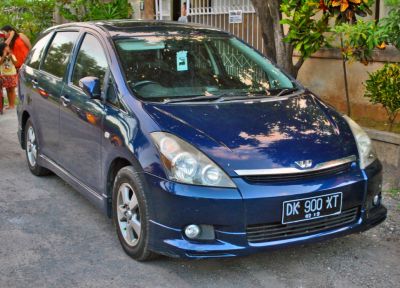 1995 Toyota Ipsum (XM1) Dimensions, Size & Specs
1995 Toyota Ipsum (XM1) Dimensions, Size & SpecsMeasurements of the 1995 Toyota Ipsum, engineered for optimal performance and comfort
| Dimensions | |
|---|---|
| Length: | 4530 mm178.3 in14.9 ft |
| Width: | 1695 mm66.7 in5.6 ft |
| Height: | 1620 mm63.8 in5.3 ft |
| Trunk Capacity: | 180 liter6.4 cu ft |
| Trunk Capacity (Max): | 1840 liter65.0 cu ft |
| Weight Specifications | |
| Curb Weight: | 1380-1490 kg3042-3285 lbs |
| Maximal permitted Weight: | 1655-1875 kg3649-4134 lbs |
| Tire Specifications | |
| Tire Size: |
|
The Toyota Ipsum (XM1) generation was produced from 1995 to 2001 and represents a practical compact minivan option designed primarily for families. Measuring 4530 mm (178.3 inches) in length, 1695 mm (66.7 inches) in width, and 1620 mm (63.8 inches) in height, the Ipsum offers a well-proportioned exterior footprint suitable for urban and suburban driving environments. The curb weight ranges between 1380 and 1490 kg (3042 to 3285 lbs), making it manageable while offering stability on the road. The maximum permissible weight varies from 1655 to 1875 kg (3649 to 4133 lbs), depending on configuration and equipment levels.
One of the standout features of the Toyota Ipsum XM1 is its flexible interior capacity. The luggage space behind the rear seats provides 180 liters (6.4 cubic feet) of storage, suitable for everyday errands and small loads. However, when the rear seats are folded down, the luggage capacity dramatically increases to 1840 liters (64.9 cubic feet), allowing for transporting bulky items or larger family trips. This versatility makes the Ipsum ideal for a range of activities from grocery runs to recreational outings.
The vehicle rides on 195/65 R14 tires, contributing to a balanced driving experience with good grip and comfort. Overall, the Toyota Ipsum (XM1) stands out as a reliable and efficient minivan from the late 90s, providing ample interior space, practical dimensions, and solid performance for families seeking a versatile vehicle.
Discover the standout features that make the 1995 Toyota Ipsum a leader in its class
Have a question? Please check our knowledgebase first.
The Toyota Ipsum (XM1) minivan, produced from 1995 to 2001, measures 4530 mm (178.3 inches) in length, 1695 mm (66.7 inches) in width, and 1620 mm (63.8 inches) in height. These dimensions position it as a compact to mid-sized minivan ideal for family transport while retaining maneuverability in urban settings.
The curb weight of the Toyota Ipsum (XM1) ranges from 1380 kg to 1490 kg (approximately 3042 to 3285 pounds), depending on the specific trim and equipment. Its maximum weight, including passengers and cargo, can range from 1655 kg to 1875 kg (about 3648 to 4132 pounds). This weight spectrum reflects the vehicle's ability to accommodate multiple passengers and cargo while maintaining efficient driving dynamics.
The Toyota Ipsum (XM1) offers a luggage capacity of 180 liters (6.4 cubic feet) with all seats in place, making it suitable for daily errands and small trips. When the rear seats are folded down, the capacity expands significantly to 1840 liters (about 65 cubic feet), providing ample space for larger cargo such as sports equipment, luggage for extended trips, or bulky items.
Yes, the Toyota Ipsum (XM1) fits comfortably into a standard garage. With a width of 1695 mm (66.7 inches) and a height of 1620 mm (63.8 inches), it is compact enough to allow easy entry and parking within typical residential garage dimensions, which usually range around 2.4 to 2.7 meters (approximately 94.5 to 106 inches) in width and around 2.1 to 2.4 meters (83 to 94.5 inches) in height.
The Toyota Ipsum (XM1) is equipped with 195/65 R14 tires. These tires provide a good balance between comfort and road grip, contributing to a smooth ride quality and reliable handling in a variety of driving conditions. The 14-inch tire diameter also helps in maintaining manageable wheel size, which can assist in efficient fuel consumption and maintenance costs.
The Toyota Ipsum (XM1), introduced in 1995, was the first generation of this model and thus does not have a direct predecessor to compare with in the Ipsum lineup. However, when compared to other minivans available in the mid-1990s, it positioned itself well with compact yet spacious dimensions. Its length of 4530 mm and moderate width allowed it to balance interior space with ease of city driving, a practical choice during its production years.
During its production between 1995 and 2001, the Toyota Ipsum (XM1) featured dimensions slightly smaller than larger minivans like the Honda Odyssey or Nissan Prairie but larger than some compact multi-purpose vehicles (MPVs) of the time. The 4530 mm length and 1695 mm width made it competitive within the compact minivan category, offering a good balance of passenger space and maneuverability compared to rivals, making it an attractive option for families seeking practical vehicles without bulk.
The Toyota Ipsum (XM1) typically came with flexible seating arrangements to accommodate up to seven passengers, featuring three rows of seats. This configuration allowed families to maximize passenger capacity or fold down the rear seats to increase cargo space substantially. The cabin was designed to prioritize comfort and utility, making it suitable for both urban commuting and longer family trips.
The curb weight range of the Toyota Ipsum (1380 to 1490 kg / 3042 to 3285 lbs) reflects the vehicle's base configuration without passengers or cargo, while the maximum weight (1655 to 1875 kg / 3648 to 4132 lbs) accounts for full load capacity. This spread influences acceleration, braking, and fuel efficiency; heavier loads can lead to slightly reduced performance but remain within safe operational limits designed by Toyota, ensuring the minivan maintains reliability and driving stability.
Yes, the Toyota Ipsum (XM1) is well-suited for drivers who need a vehicle that balances compact size for easier urban driving with substantial interior space. Its dimensions facilitate parking and navigating city streets, while its flexible seating and high luggage capacity (especially with rear seats folded) accommodate diverse cargo and passenger needs. This combination makes the Ipsum a practical and versatile minivan choice from its production era.
Discover similar sized cars.

| Production: | 1996-2001 |
|---|---|
| Model Year: | 1996 |
| Length: | 4530 mm178.3 in |
| Width: | 1695 mm66.7 in |
| Height: | 1620 mm63.8 in |

| Production: | 2005-2009 |
|---|---|
| Model Year: | 2005 |
| Length: | 4560 mm179.5 in |
| Width: | 1695 mm66.7 in |
| Height: | 1590-1600 mm62.6-63.0 in |

| Production: | 2003-2005 |
|---|---|
| Model Year: | 2003 |
| Length: | 4550 mm179.1 in |
| Width: | 1695 mm66.7 in |
| Height: | 1590-1600 mm62.6-63.0 in |

| Production: | 2001-2007 |
|---|---|
| Model Year: | 2001 |
| Length: | 4550-4570 mm179.1-179.9 in |
| Width: | 1695 mm66.7 in |
| Height: | 1590-1605 mm62.6-63.2 in |

| Production: | 2018-2021 |
|---|---|
| Model Year: | 2018 |
| Length: | 4615 mm181.7 in |
| Width: | 1735 mm68.3 in |
| Height: | 1660 mm65.4 in |
